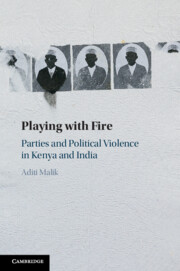Book contents
- Playing with Fire
- Playing with Fire
- Copyright page
- Dedication
- Contents
- Figures
- Tables
- Acknowledgments
- Abbreviations
- 1 Parties and Political Violence
- 2 A Theory of Party Instability and Political Violence
- 3 The Development of Divergent Parties and Party Systems in Kenya and India
- 4 Party Instability and Political Violence in Kenya
- 5 Party Fragility and Subnational Patterns of Violence in Kenya’s Rift Valley and Coast Regions
- 6 Party Stabilization, Declining Riot Violence, and New Modalities of Political Conflict in India
- 7 Party Politics and Subnational Trajectories of Riot Violence in India’s Hyderabad and Meerut Cities
- 8 Party Instability and Political Violence
- 9 Conclusion
- Book part
- References
- Datasets
- Index
4 - Party Instability and Political Violence in Kenya
Published online by Cambridge University Press: 25 October 2024
- Playing with Fire
- Playing with Fire
- Copyright page
- Dedication
- Contents
- Figures
- Tables
- Acknowledgments
- Abbreviations
- 1 Parties and Political Violence
- 2 A Theory of Party Instability and Political Violence
- 3 The Development of Divergent Parties and Party Systems in Kenya and India
- 4 Party Instability and Political Violence in Kenya
- 5 Party Fragility and Subnational Patterns of Violence in Kenya’s Rift Valley and Coast Regions
- 6 Party Stabilization, Declining Riot Violence, and New Modalities of Political Conflict in India
- 7 Party Politics and Subnational Trajectories of Riot Violence in India’s Hyderabad and Meerut Cities
- 8 Party Instability and Political Violence
- 9 Conclusion
- Book part
- References
- Datasets
- Index
Summary
This chapter combines national-level violence and volatility data with in-depth elite interviews to demonstrate the relationship between short projected party lifespans and recurring bouts of ethnic party violence in multiparty Kenya. The chapter proceeds in three phases from the KANU era to the period after the promulgation of the country’s new constitution in 2010. The central findings reveal that although Kenyan voters are not lacking in information about the political nature of party conflicts and actually reject violence-wielding politicians, high levels of party replacement and attendant changes in coalitional arrangements tend to prevent them from holding these leaders to account. As a result, politicians from different parties have been able to organize and sponsor violence on a repeated basis.
Keywords
- Type
- Chapter
- Information
- Playing with FireParties and Political Violence in Kenya and India, pp. 76 - 99Publisher: Cambridge University PressPrint publication year: 2024

